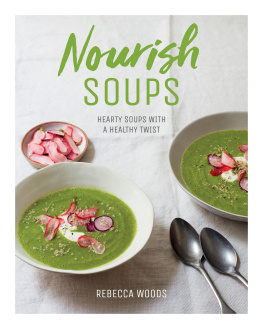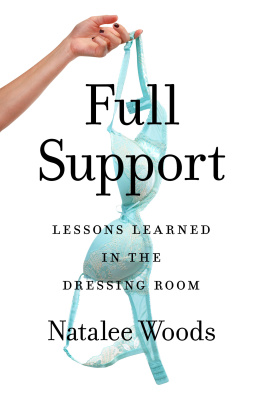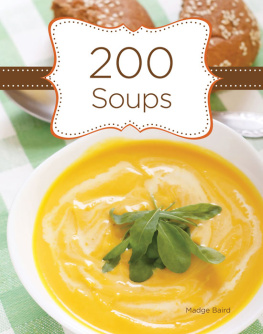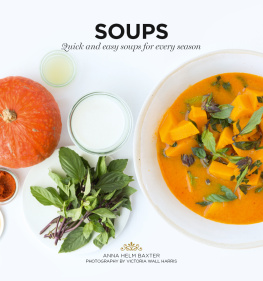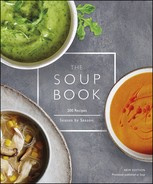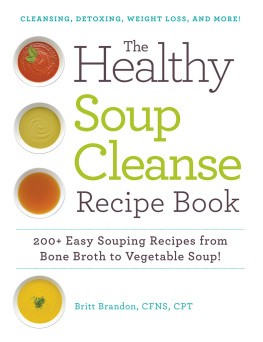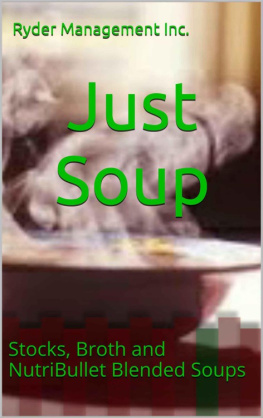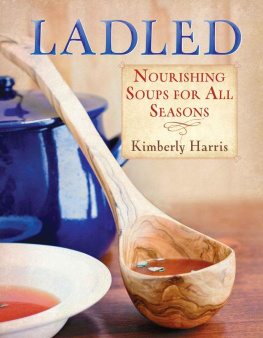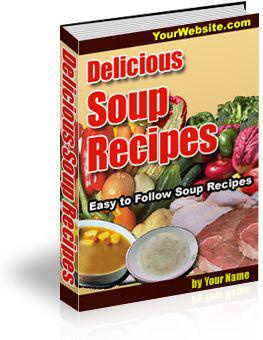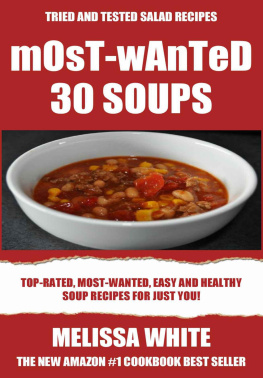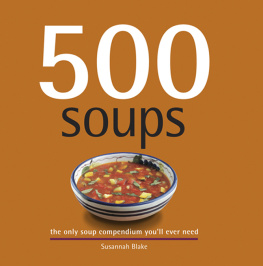CONTENTS
Who doesnt love soup? was the response most often received from friends and family when I told them the subject of this book. It turns out that everyone is surprisingly effusive on the matter of soup. The rows and rows of pots and cans of ready-made soup in supermarket aisles and chillers are testament to its belovedness. In fact, I suspect were suspicious of anyone who claims not to eat soup at least once in a while.
Perhaps this is because its tricky to dislike something that can literally be anything you want it to be. And to get all etymological on you, thats the whole point soup, in its original sense, is a jumble, a mixture of different elements. You can add anything you like, to make it fit for any occasion a light brothy starter in an Asian style on a summery day, or a hearty warming wintery mix, packed with satisfying grains and tender meat. But whatever you choose, its never better than when you make it yourself and there are few foods that wont taste good when suspended in a bowl of delicious broth.
But it goes beyond flavour, too; for me, soup is a food that is so inextricably intertwined with growing up from a bowl of chicken soup on a sick day or a can of cream of tomato (theres a reason Warhol immortalized this) with a cheese toastie as a child, to a pot of noodly pho enjoyed on a plastic stool at the side of a Hanoi street, those happy memories bring comfort. It has unequalled nostalgic power that will ground you, not just physically, but emotionally, too.
Ive tried to rein in my classic French cookery training and bring a healthy slant to the recipes here. They are wholesome, packed with fresh vegetables, whole grains and, for the most part, lean proteins. While a few liberties have been taken with a smidgen of butter, a drizzle of cream or a splash of alcohol here and there for that all-important flavour, on the whole I have kept them as concoctions that will leave you feeling nourished and energized, satisfied not soporific.
Are there even 60 soup recipes? one friend asked. Well, thats rather the point. There are as many as you want there to be. Let this book be just a starting point.
One of the joys of soup is its simplicity. Theres very little that you need in the way of equipment or even cooking expertise. But there are a few hints and tips that might help you along the way, especially if you decide to go off-piste and devise your own soup concoctions rather than strictly following the recipes here something I wholeheartedly encourage.
QUALITY INGREDIENTS
The simplicity of many of the soups here means that often they are only as good as their ingredients, especially when it comes to meat and fish. Try to buy the best produce that you can afford and your soup will be all the better for it. You can, of course, be a little more flexible with veggies pured soups are one of the best ways to be economical and use up vegetables that are a little past their best.
BROTHY OR CREAMY?
While a thick pured and spiced root veg soup might be an ideal warmer-upper for a cold day, a light vegetable or seafood broth makes a great summer starter. Theres no need to pick a favourite, but its worth investing in a proper blender/liquidizer if you are going to be making lots of pured soups for speed and smoothness. Stick immersion blenders are great for partially blending soups to thicken them (see ), but there will probably always be lumps that make it through if youre trying to blend the whole pan. Of course, many of the soups here have been left as broths, especially those including meat, which is less suitable for blending, and are better as hearty stewy soups.
COOKING TIMES
Ive tried to include a mixture of methods, some very quick and simple, and others which depend on a more lengthy cooking process. While some of the cooking processes may seem a bit drawn out, sometimes theres no shortcut to deep flavour and tender meat (or beans in the case of the ). Once a slow-cooked soup is bubbling away, it doesnt really need a lot of attention, so dont see it as extra work. It will also fill the house with deliciously comforting smells.
ADDING FLAVOUR
Keeping a basic storecupboard of liquid seasonings such as soy sauce, Worcestershire sauce, balsamic vinegar, Tabasco, etc. and dried herbs and spices means you will have plenty of tools to add a hit of flavour, should your soup need perking up a little. If you can find space in the garden or on the windowsill for a few pots of fresh herbs, too, their power cant be overstated.
A WORD ON SEASONING
For most healthy adults, seasoning food properly is not a health hazard. At the risk of antagonizing cardiologists everywhere, Im inclined to believe that if youre enjoying freshly cooked homemade food at each meal of the day and keeping processed meals and snacks to an absolute minimum, its very unlikely that you will be consuming too much salt by adding it to your soups, and the flavour will suffer if you dont use it. Season sagely
THICKENING
If youre making a soup in which the main ingredient is a vegetable, especially a green, leafy one with a high water content, youll need something to thicken it so that it feels more substantial. Potato is classically used for this, but Im also a big fan of using rice, which adds a different, delicate flavour to the soup. You can also use cornflour [cornstarch], slaked with a drop of water then added back into the soup and cooked for a few minutes, like I have in the . Or, you can simply blend a little of the soup (with a stick blender or by blitzing a little in a blender and returning it to the pan) and the small proportion of pured solids will add body.
STOCK
Im not a huge fan of dehydrated stock cubes. Sometimes, theres just no hiding that artificial tang they seem to imbue everything with, especially in more delicately flavoured soups, such as asparagus. Although, if you are adding lots of spices or starchy vegetables to a soup, they are usually fine, and are admittedly a lot cheaper than other options. I have provided the following recipes for basic stocks for meat, fish and vegetables, but if time is short, I know corners do need to be cut. Do try to use either a pot or pouch of ready-made stock, or at least the jelly stock pots, which dont seem to be so processed in flavour as the dried cubes. Several of the recipes have a stock written into the recipe, which it is best to follow for the optimum flavour and to properly (slow) cook any meat or fish in the soup.
MEAT STOCK
MAKES ABOUT 1.5 LITRES [1 QUARTS]
1.5kg [3lb] chicken or beef bones or carcasses (depending on the recipe) a little olive oil, to drizzle 2 large carrots, peeled and chopped into chunks 1 large onion, halved 2 celery sticks, chopped into chunks 1 large leek, chopped into chunks a bouquet garni made up of parsley stalks, thyme sprigs and a bay leaf a few black peppercorns
__________
Preheat the oven to 190C fan (375F) Gas 5.
Put the bones into a large roasting pan and drizzle with a little oil not too much or you will have a fatty stock. Toss the bones to coat them in the oil, then roast for about 30 minutes until the bones are browned. You can skip this step and put the bones straight in the saucepan with the water, if you wish, but roasting the bones really does help bring out their meaty flavour.

